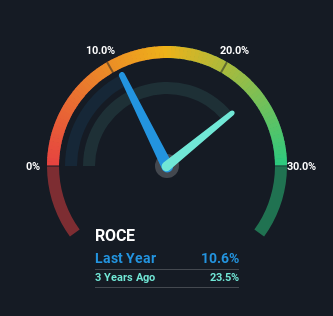- Israel
- /
- Food and Staples Retail
- /
- TASE:DIPL
Some Investors May Be Worried About Diplomat Holdings' (TLV:DIPL) Returns On Capital
What trends should we look for it we want to identify stocks that can multiply in value over the long term? Firstly, we'd want to identify a growing return on capital employed (ROCE) and then alongside that, an ever-increasing base of capital employed. Basically this means that a company has profitable initiatives that it can continue to reinvest in, which is a trait of a compounding machine. Although, when we looked at Diplomat Holdings (TLV:DIPL), it didn't seem to tick all of these boxes.
Understanding Return On Capital Employed (ROCE)
If you haven't worked with ROCE before, it measures the 'return' (pre-tax profit) a company generates from capital employed in its business. The formula for this calculation on Diplomat Holdings is:
Return on Capital Employed = Earnings Before Interest and Tax (EBIT) ÷ (Total Assets - Current Liabilities)
0.11 = ₪119m ÷ (₪2.0b - ₪907m) (Based on the trailing twelve months to June 2023).
So, Diplomat Holdings has an ROCE of 11%. In absolute terms, that's a satisfactory return, but compared to the Consumer Retailing industry average of 7.9% it's much better.
View our latest analysis for Diplomat Holdings

While the past is not representative of the future, it can be helpful to know how a company has performed historically, which is why we have this chart above. If you're interested in investigating Diplomat Holdings' past further, check out this free graph of past earnings, revenue and cash flow.
What Can We Tell From Diplomat Holdings' ROCE Trend?
When we looked at the ROCE trend at Diplomat Holdings, we didn't gain much confidence. To be more specific, ROCE has fallen from 24% over the last four years. However, given capital employed and revenue have both increased it appears that the business is currently pursuing growth, at the consequence of short term returns. If these investments prove successful, this can bode very well for long term stock performance.
On a related note, Diplomat Holdings has decreased its current liabilities to 45% of total assets. That could partly explain why the ROCE has dropped. What's more, this can reduce some aspects of risk to the business because now the company's suppliers or short-term creditors are funding less of its operations. Since the business is basically funding more of its operations with it's own money, you could argue this has made the business less efficient at generating ROCE. Keep in mind 45% is still pretty high, so those risks are still somewhat prevalent.
What We Can Learn From Diplomat Holdings' ROCE
Even though returns on capital have fallen in the short term, we find it promising that revenue and capital employed have both increased for Diplomat Holdings. These growth trends haven't led to growth returns though, since the stock has fallen 29% over the last year. So we think it'd be worthwhile to look further into this stock given the trends look encouraging.
Diplomat Holdings does have some risks, we noticed 4 warning signs (and 1 which is a bit unpleasant) we think you should know about.
If you want to search for solid companies with great earnings, check out this free list of companies with good balance sheets and impressive returns on equity.
New: Manage All Your Stock Portfolios in One Place
We've created the ultimate portfolio companion for stock investors, and it's free.
• Connect an unlimited number of Portfolios and see your total in one currency
• Be alerted to new Warning Signs or Risks via email or mobile
• Track the Fair Value of your stocks
Have feedback on this article? Concerned about the content? Get in touch with us directly. Alternatively, email editorial-team (at) simplywallst.com.
This article by Simply Wall St is general in nature. We provide commentary based on historical data and analyst forecasts only using an unbiased methodology and our articles are not intended to be financial advice. It does not constitute a recommendation to buy or sell any stock, and does not take account of your objectives, or your financial situation. We aim to bring you long-term focused analysis driven by fundamental data. Note that our analysis may not factor in the latest price-sensitive company announcements or qualitative material. Simply Wall St has no position in any stocks mentioned.
About TASE:DIPL
Diplomat Holdings
Operates as a sales and distribution company in the fast-moving consumer goods sector.
Flawless balance sheet with acceptable track record.
Similar Companies
Market Insights
Community Narratives



